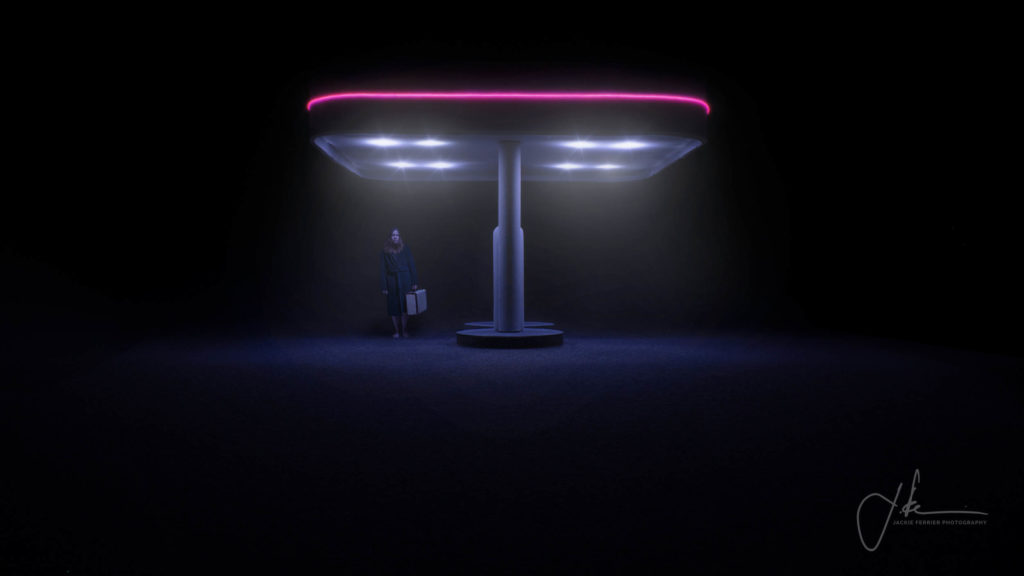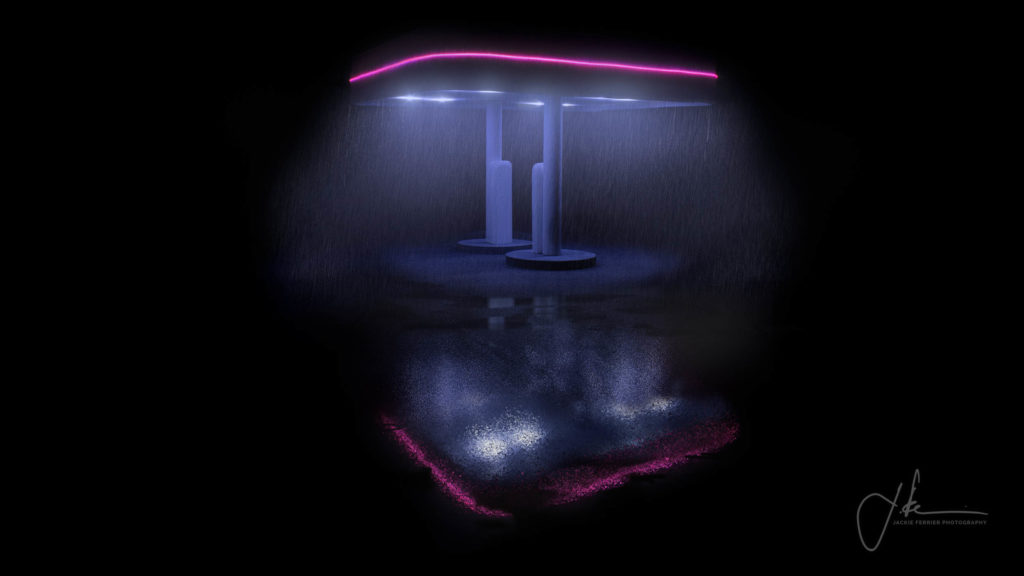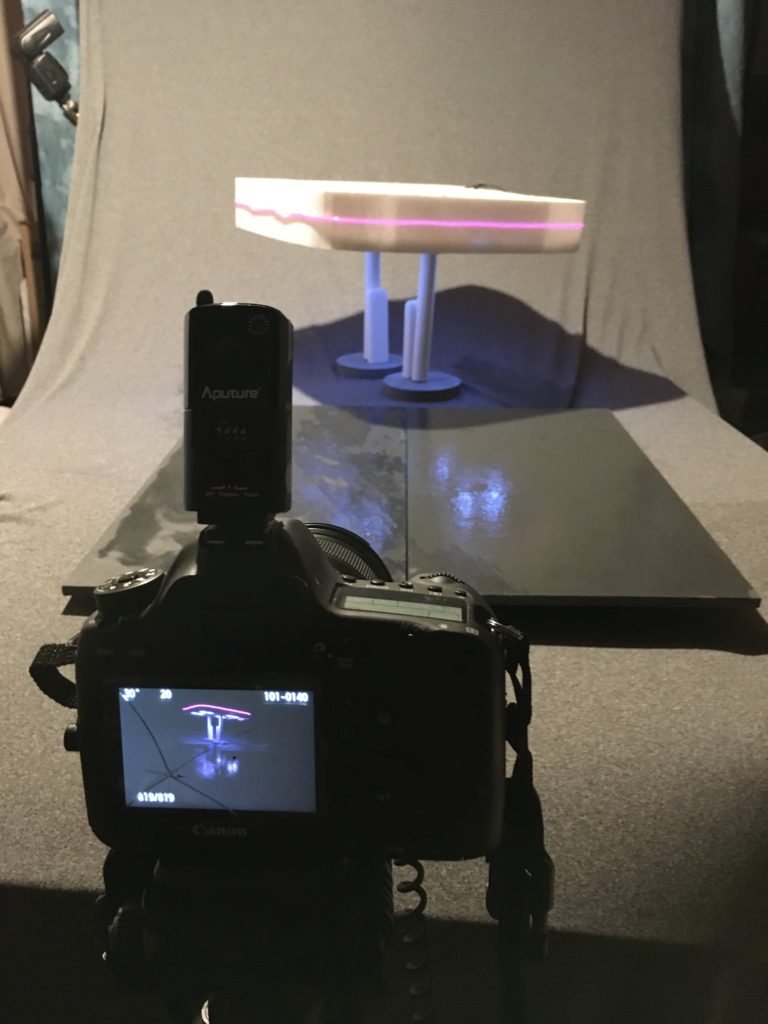Part one is here. You’ll see I strayed a ways away from my original concept.
I don’t know if there is anything I have done so far that caused me as much thinking. Of course, there is always the thinking around the concept, and then the thinking around the build, and then the shooting and post-production. And then there was the rebuilding. And the reshooting. And the re-dos in post. But I thought a lot about this. And I procrastinated when couldn’t figure out how to solve its problems.
The image looks so simple, how could it be that complicated?

Simmering in the background were some other things, too, like, am I really shooting another image where the central character is doing nothing?
Part of it had to do with where the motivation/concept came from. I actually went back over my notes and realized that it got muddy pretty much from the start.
Where the gas station gets a new role
You see I have a thing for certain night shots. For a while there I took to prowling around the neighborhood at night to shoot. But I currently live in a suburb and there isn’t much fog here, and there aren’t many of the structures I was interested in. I talked about the original concept here, but then I discovered that the lighting changed the entire concept. It no longer looked exactly abandoned. It looked modern, futuristic even. Could it even be abandoned with the lights on? What was I thinking? Ok, maybe. But then it’s the wrong lighting.
The first dilemma was a simple one. I liked its lighting, it felt right. It felt gas station-y.
At least the first build did. These images are a result of build number two which I built to get the lighting even better and fix an issue with the poles. And I got very stubborn about sticking to what I had built because I liked it.
So maybe it’s not abandoned. Maybe it’s something else. Whatever. See, I don’t have to overthink things.
Static vs Dynamic
We all like dynamic images, right? Go for the dynamo! When it came time to shooting the self-shots I decided I’d do a variety of different poses. I got the boring old standing-around shot (again?), of course, because that was what I had envisioned, but I did other ones, too. And I came up with one that I really liked. It was dynamic, just complex enough, and so that was going to be the shot I used.
I liked the shot. One problem. Or I thought it was one problem. It just didn’t work.
The Viewer and the Relationship to Stills vs Film
In fact that kind of lonely feeling I thought I was going for wasn’t there as soon as I put the character in. Why? That was the first problem.
It lead me down a long path of musing about the nature of the viewer of a photograph vs a film viewer. See, in a film, you can create a shot with a character in a place that feels lonely. But as soon as I put my person in my image, the place no longer felt lonely.
Take the character out, it feels lonely. Put it in, you no longer feel lonely. I was unsure if it was just my image or all images. So I did a search for “lonely” and sure enough, all those images of lonely people don’t feel lonely, even if you understand the concept of loneliness is being communicated. Why? Because when you put a person into the frame, you are no longer alone anymore.
I mean, you are not necessarily any more unlonely, but loneliness is no longer your focus. If someone is there you are not alone. I wasn’t entirely sure I was understanding the effect of it correctly, but it suggested that the role of the viewer of a photograph is different than it is for a film viewer because you can feel loneliness with a character. Could that be?
I did a bunch of thought experiments. Did it have to do with the idea that in film there is the invisible fourth wall? Or that somehow because we are used to people looking back out at us in photos and selfies that we have been conditioned to seeing the person separately? Is the experience is different? What about the news – people are looking back at us then? What about documentaries? Or was this all something else? Could films really be such a different experience than looking at still images? I mean from a pure image relationship what is the difference between them other than one is still and one is not?
I eventually concluded that you can’t look at these things in isolation. It had to do with the difference in the storytelling aspect of film and our relationship to the character, When we first meet a character in a film they are a stranger to us (even if we recognize the actor). Over time, hopwever, if the script and director are doing their jobs right, we begin to identify with the character, enabling us to live vicariously through them, feeling their feelings, experiencing their experiences, and experiencing that odd kind of dream-like double-think. We are them, they are us.
A character in a still image, on the other hand, in some ways is forever unknowable to us. They are “other”. So whether or not the character “knows” we’re there by looking back out at us, we remain separate. So seeing a character in an image, separate from us means their’s two of us. So we’re not alone.
So once I had that worked out, I realized that “lonely” was not going to work.
And was lonely even what I was even going for? Maybe isolated? Maybe something? Dammit, just get it done! Self-doubt has a way of creeping in slowing you down.
Get clear on the subject
What is the picture about? I used to read that when I was newly learning about photography and I found it maddening because I just didn’t get it. It’s about the thing. Right there! What are you asking?! But now that I understand I think maybe it’s either not quite the right question to ask. Maybe you just don’t know what you don’t know.
A better question for me might have been, what am I supposed to be looking at, or what is the feeling of it that made you want to shoot it? I am not even sure I would have been able to answer that either. But because photography incorporates so many technical aspects it’s easy to get lost on the technical and the stuff of it. Often beginning photographers end up with a cluttered image. We want to put everything into it. Sometimes we need to know when to simplify things.
Which brought me to the next problem. I put my chosen pose, the dynamic one, into the shot. A strange thing happened. Suddenly the sense of place no longer seemed to matter as much. The place became a background, an accessory, maybe even a distraction. Sure it lent to the feeling, I guess, but it wasn’t about the place. It became all about that character. The character upstaged the place.
And that’s when I realized that I wasn’t clear on my subject and hadn’t been from the start. I created a story, but the thing I actually wanted to shoot was the feeling of the place.
And the character. But was I just being stubborn about it? So that is why this image became two. One with, one without.

The Elusive Feeling
Now it was not just the problem of identifying the subject of the image. It was also not clearly identifying the feeling of it.
Sure, it can be lonely at night, but it wasn’t lonely I was actually looking for I realized. Or even that sense of futility that I was thinking about: I had this idea that the gas station was like a mirage in the distance, only to arrive and find there is nothing there to help you. This image was going to be the moments after that realization, or perhaps the sinking in of it.
But that was not really what prompted me to start this idea in the first place. It had started with the place.
What attracts me to the light at night was the eerie, unsettling quiet of it, combined with the man-made electric magic glow. I can’t quite find the words for it, which is why it’s an image. There’s almost an other-world component to the night when no one is around.
Had I more accurately identified that quality, I would have realized that the character couldn’t be more dynamic. The dynamic aspect of the character in the shot I liked made it unbalanced. The thing that made me like the pose simply drew too much attention. She had to acquiesce to the night. Become part of it with all that she brought to it. Quiet and flat. The night has a presence we all recognize when we are out in it alone and there is no one around. It’s bigger than us.
So, even while my self-doubt was raging over using yet another static-looking person, I knew I couldn’t put the pose I actually liked better in the shot. It just didn’t go. And with that knowledge, and with the understanding that my image was not about the gas station idea, this place of transience, but the quality of the light and the darkness, I left the pumps unfinished. I feel it’s better that way. Is it a gas station? I don’t think it is. Does it matter? It’s no longer about that.
Perspective and the Inverse law
Oh that sounds so mathy, and I feel so smart!
Except I can’t quite figure it out. The other dilemma I had was this feeling that the original image with the rain looked wrong. This is a model and I shot it, and yet as I was working with the image with the rain I had this nagging feeling the perspective was off. I’m like, how is this possible? It’s REAL(ish). Well, the reflections weren’t, but everything else was.
So I go back to the inverse square law. Usually, when you hear a photographer talk about this, they are referring to the light, and you really don’t need to know how to do the math. If anything, you just need to understand that light falls off quicker the closer it is to something. But from what little I understand of it, I think physicists might tell you the inverse square law relates to everything that has a physical quantity. Or something. Let me explain how it relates.
I am looking at that structure, and with my first shots, I’m thinking that maybe you see too much of the underside of the roof. I had initially shot it from a fairly low angle. It sort of worked, but not quite. So I re-shot it. I was happy with that until I started to put the rain and reflections in. Now it was the ground that bothered me. Why it is feeling like it’s coming too far at me instead of down when wet reflections tend to go straight down from my research and they were in the image. There was just something weird about it, and while I sensed it was the perspective, I just couldn’t figure out how the reflections I created could be making me feel that.
And I reshot it yet again this time using a variety of different reflective surfaces. I realized that I had my reflections wrong, but turns out, that really wasn’t the issue either. The nagging thing that was bothering me if anything, got worse. I became convinced it was what I could see of the tops of the base. How that be? It’s reality!
Because really, if I was a certain amount of inches away from the model, and I translate this into feet because i am working at a 1:12 scale, well, does it really even matter where I am shooting it from? It should look right. But what I haven’t quite figured out is how lenses fit into the mix, but we see things rendered differently from all sorts of different lenses. A 90mm is not going to look like a 14mm and we accept that in an image. So should it matter?
There is a math problem here, I just don’t know what it is. I started to suspect it has something to do with the inverse square law, perspective and what you see of the horizontal planes. The farther away something is, the higher it is in a 2d rendering, which means you can’t see on top of it so well, right? Assuming that a 35mm lens best represents the human eye, shouldn’t that be irrelevant? I can’t even imagine a scaled-down 35mm lens – what would a 2.9mm lens would look like? With a tiny little camera sensor?
That way leads to madness.
Finally, I went back to some shots I had taken at night of different structures and found one of the Ajax Library main branch that I had shot on a 14mm lens. I’m looking at that shot, and some others, and I’m thinking, there’s just no way you be able to see the tops the way I had them in the image I was working on and still be able to see that much of the entire structure. Didn’t matter if what I shot is real. Maybe it’s just a matter of camera angle, or maybe it’s not.
I just decided to fix it on intuition. I might not have got it perfectly but it least it’s not making me mental. Not yet anyway.
Maybe someday when I get a budget for a documentary, I’ll talk to a physicist about it.

I find this shot amusing, both for the rickety nature of it all, and also because of the flash that’s poking its head out from behind the background.
In actual fact, I had already shot the station several days earlier and had actually taken it apart. Because the roof was still intact, I just pinned it back together so that I could get what I needed to shoot the wet surfaces and reflections. I had to carefully balance two battery backs on the top so that it would stand properly.
